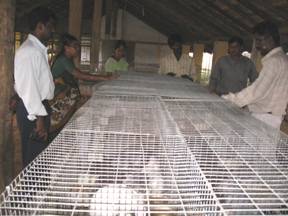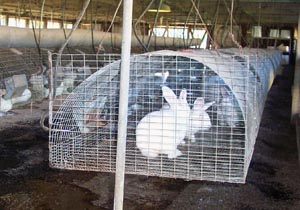HOUSING OF RABBIT
A good housing facility with adequate arrangement of ventilation is the most important factor in rabbit house. Good house denotes proper cages or hutches and arrangement for feeding, watering, cleaning. House is important to keep the broiler rabbit in one roof and to prevent them from running away. There are several ways of housing rabbits. This depends on financial involvement and the climate of the place. In backyard rabbit locally available materials are used. The commonly used materials include tin cans, bamboos, old boxes, wood, bricks, asbestos sheets etc. Katcha floor and walls may be the components of the house.
1. Ideal Environment for Rabbit Rearing
(a) Lighting
Light has got paramount importance concerning reproductive efficiency. Natural or artificial light is required to be provided. If a buck is not provided with light exposure at least for 8 to 12 hours, its spermatogenesis will be hampered. On the other hand, a breeding doe will require at least 6 hours light exposure for its sexual performance and fertility. It is better to provide artificial light in the rabbit as per situation of natural light. It may be suggested to use 100 watt bulb or 40 watt fluorescent tube 2 metre above the ground at a difference of 3 metre for a period of 16 hours. When the day light falls, in that case light may be kept on at 6 a.m. and off at 8 p.m. Light should not be switched on or off very suddenly since this may make the rabbit to leap here and there due to agony leading to fracture and other injuries. Much lighting is not required for young rabbit only 1 to 2 hrs will do.
(b) Temperature
Rabbits can tolerate a wide variation of temperature ranging from 5°C to 33°C. But, the ideal comfortable temperature required by the rabbits ranges from 10°C to 26°C. The winter temperatures in Indian climate in most of the places excepting hilly regions are conducive to rabbit’s health. Rabbits in general, can tolerate the cold wave rather than the hot wave. Temperature in summer time may cause heat stress in rabbits. Therefore, adequate measures should be taken to reduce heat stress through cooling and good ventilation. Care should be taken to avoid draught. Adult rabbit can minimize hot through stretching of their bodies. Similarly to conserve heat they curl in lowered environmental temperature. But, young rabbit may not adjust with the surrounding fluctuation of temperature and may die. This aspect should be well taken care of by the rabbit keeper.
(c) Humidity
From systemic point of view rabbits can not tolerate too much moist condition. Humidity in rabbit house should remain within 50% level. All devices should be applied during rainy season to minimize humidity level. High temperature along with high humidity may adversely affect the health of rabbits. All the watering equipments should be kept in such a way so that there is no leakage of water. Water bottles can be kept outside to avoid breakage and thus accelaration of humidity level.
(d) Ventilation
A clean dirt and smoke free environment are the essential attributes for free breathing of rabbits. There should be proper arrangement for free movements of air. The location for air free zones in the house should be taken care of. The requirement of comfortable fresh air is most needed during the hot days in the summer. Strong draught should be avoided as far as possible. Some shady trees may be planted near and around the rabbitry to allow cool air during summer.
(e) Noise
Though there is no specific information available regarding the impact of sound pollution of rabbits but as a general practice noise should be avoided as far as possible. Noise may pose detrimental effect on the health of the rabbits since it may interfere with the copulatory instinct and maternal characters.
(Source: Namakkal KVK, Rabbit Farming)
Rabbits are housed in cages, pens and hutches
Cages: Cages of does should be of 90 cm length, 70 cm breadth and 50 cm height. Those of bucks should be of 60 cm length, 60 cm breadth and 45 cm height for bucks. Cages are made out of wood, bamboo, or welded mesh. The size of wire mesh should be 1cm x 1cm for the bottom and 2.5 cm x 2.5 cm for the sides. From the ground to bottom to of the cage should be 75 cm to 90 cm high. The legs of the cages should be in such a manner that rats and snakes could not cause nuisance and it is advised to fix metal guards to the legs.
.

(Photo source: KVK, Namakkal )
Cages should be placed in a shed that is constructed in cooler surroundings.
Pen: Young rabbits after weaning are kept in groups in the pens. Each pen measures 1.2 m breadth, 1.5 m length and 0.5 m height. About 20 weaning rabbits are housed in each pen. Once rabbits attain puberty, they may be housed singly; especially those adult males. If they are kept together they will fight and get injured.
Hutches: Outdoor hutches should be in a sheltered location, raised and with a slopping waterproof roofing. Hutch should be well protected from predators. Hutch is made out of (i) wood (ii) asbestos, and (iii) welded wire mesh.
Nest box: Nest boxes vary in size and design but in general the size is 50 cm long, 30 cm broad and 15 cm high. Nest boxes are made out of wood and should have provision for adequate drainage and ventilation. It is advisable to have a wire mesh bottom.

Feeders and waters: Feeders are generally made out of Aluminum or galvanized iron sheets. Feeders may be designed in such a way that they can be attached to the front panel of the cage and can be filled from outside without opening the doors of the hutch or cage. Automatic pipeline or bottles watering system are used widely in commercial rabbit farms. Glazed earthenware pots can be used for watering in cages.
(source: www.vuatkerala.org )
|